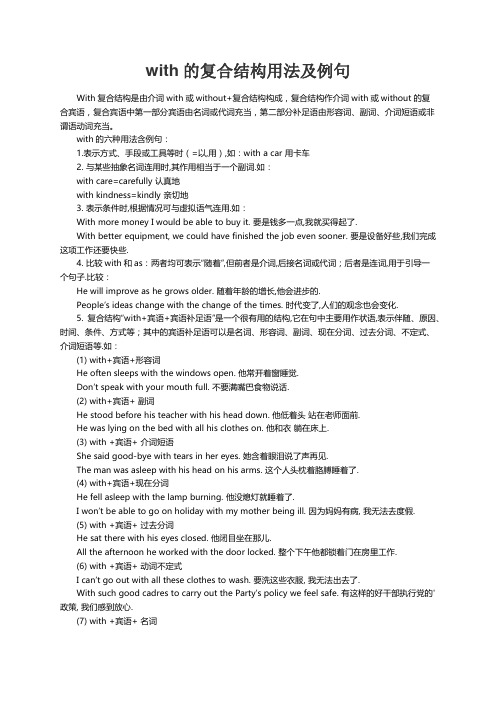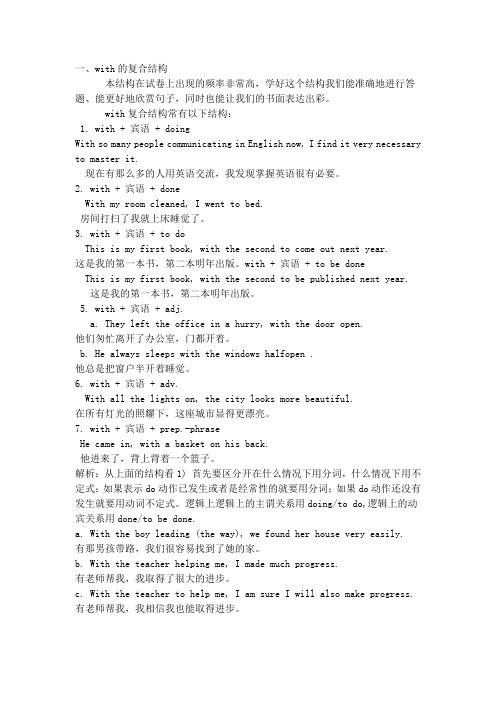语法之with+复合宾语
with的复合结构用法及例句

with的复合结构用法及例句With复合结构是由介词with或without+复合结构构成,复合结构作介词with或without的复合宾语,复合宾语中第一部分宾语由名词或代词充当,第二部分补足语由形容词、副词、介词短语或非谓语动词充当。
with的六种用法含例句:1.表示方式、手段或工具等时(=以,用),如:with a car 用卡车2. 与某些抽象名词连用时,其作用相当于一个副词.如:with care=carefully 认真地with kindness=kindly 亲切地3. 表示条件时,根据情况可与虚拟语气连用.如:With more money I would be able to buy it. 要是钱多一点,我就买得起了.With better equipment, we could have finished the job even sooner. 要是设备好些,我们完成这项工作还要快些.4. 比较with和as:两者均可表示“随着”,但前者是介词,后接名词或代词;后者是连词,用于引导一个句子.比较:He will improve as he grows older. 随着年龄的增长,他会进步的.People’s ideas change with the change of the times. 时代变了,人们的观念也会变化.5. 复合结构“with+宾语+宾语补足语”是一个很有用的结构,它在句中主要用作状语,表示伴随、原因、时间、条件、方式等;其中的宾语补足语可以是名词、形容词、副词、现在分词、过去分词、不定式、介词短语等.如:(1) with+宾语+形容词He often sleeps with the windows open. 他常开着窗睡觉.Don’t speak with your mouth full. 不要满嘴巴食物说话.(2) with+宾语+ 副词He stood before his teacher with his head down. 他低着头站在老师面前.He was lying on the bed with all his clothes on. 他和衣躺在床上.(3) with +宾语+ 介词短语She said good-bye with tears in her eyes. 她含着眼泪说了声再见.The man was asleep with his head on his arms. 这个人头枕着胳膊睡着了.(4) with+宾语+现在分词He fell asleep with the lamp burning. 他没熄灯就睡着了.I won’t be able to go on holiday with my mother being ill. 因为妈妈有病, 我无法去度假.(5) with +宾语+ 过去分词He sat there with his eyes closed. 他闭目坐在那儿.All the afternoon he worked with the door locked. 整个下午他都锁着门在房里工作.(6) with +宾语+ 动词不定式I can’t go out with all these clothes to wash. 要洗这些衣服, 我无法出去了.With such good cadres to carry out the Party’s policy we feel safe. 有这样的好干部执行党的'政策, 我们感到放心.(7) with +宾语+ 名词He died with his daughter yet a schoolgirl. 他去世时,女儿还是个小学生.With复合结构:一、with或without+名词/代词+形容词例句:1.I like to sleep with the windows open.我喜欢把窗户开着睡觉。
With 复合结构【精】【骆驼整理】

With 复合结构【精】With 复合结构“With复合结构”即:“with +宾语+补足语”With复合结构在英语中,尤其是在书面语中是一种很常用的结构,它既可以充当状语,又可以充当定语。
由于“with 复合结构”在逻辑上是一个主谓关系完整的结构,因而,它也可以用相应的从句和分句来代替。
一、with复合结构的构成它是由介词with或without+复合结构构成,复合结构作介词with或without的复合宾语,复合宾语中第一部分宾语由名词或代词充当,第二部分补足语由形容词、副词、介词短语、动词不定式或分词充当,分词可以是现在分词,也可以是过去分词。
形容词副词表示状态介词短语With+宾语+ 名词V-ing 主谓、进行V-ed 动宾、完成to do 主谓、将要发生标志:作状语用逗号隔开,with结构放句子前后皆可;做方式、伴随状语和定语时,不用逗号隔开,放在句子后面。
1、with+宾语+副词The square looks more beautiful with all the lights on.所有的灯都亮时,广场看起来更美丽。
With his parents away,Tom becomes more naughty.父母不在,汤姆变得更加淘气。
The girl fell asleep, with the light on.女孩睡着了,灯还亮着。
With the meal over , we all went home.(做时间状语)吃完饭,我们都回家了。
Two men with life jackets on are floating along the river.两个身穿救生衣的男人正沿着河流漂浮着。
He fell asleep,with the radio on.他睡着了,录音机还开着。
2、with+宾语+形容词With the weather so close and stuffy, ten to one it’ll rain presently. 天气这么闷热,十之八九要下雨。
with的复合结构的三种情况(每种情况写两个例句)

with的复合结构的三种情况(每种情况写两个例句)with结构也称为with复合结构,是由with+复合宾语组成,常在句中做状语,表示谓语动作发生的伴随情况、时间、原因、方式等.其构成有下列几种情形:1、with + 名词 (或代词) + 现在分词此时,现在分词和前面的名词或代词是逻辑上的主谓关系.例如:With prices going up so fast,we can't afford luxuries.由于物价上涨很快,我们买不起高档商品.(原因状语)With the crowds cheering,they drove to the palace.在人群的欢呼声中,他们驱车来到皇宫.(伴随情况)2、with + 名词 (或代词) + 过去分词此时,过去分词和前面的名词或代词是逻辑上的动宾关系.例如:I sat in my room for a few minutes with my eyes fixed on the ceiling.我在房间坐了一会儿,眼睛盯着天花板.(伴随情况)She had to walk home with her bike stolen.自行车被偷,她只好步行回家.(原因状语)3、with + 名词 (或代词) + 形容词I like to sleep with the windows open.我喜欢把窗户开着睡觉.(伴随情况)With the weather so close and stuffy,ten to one it'll rain presently.大气这样闷,十之八九要下雨.(原因状语)4、with + 名词 (或代词) + 介词短语With the children at school,we can't take our vacation when we want to.由于孩子们在上学,所以当我们想度假时而不能去度假.(原因状语)The soldier had him stand with his back to his father.士兵让他背朝着他的父亲站在那儿.(行为方式)5、with + 名词 (或代词) + 副词He fell asleep with the light on.他睡着了,灯还亮着.(伴随情况)The boy stood there with his head down.这个男孩低头站在那儿.(伴随情况)6 、with + 名词 (或代词) + 动词不定式此时,不定式表示将发生的动作.例如:With no one to talk to,John felt miserable.由于没人可以说话的人,约翰感到很悲哀.(原因状语)With a lot of work to do,he wasn't allowed to go out.因为还有很多工作要做,他没有被允许外出.(原因状语)。
语法with+复合宾语”结构

With + 复合宾语结构请看NMET2000高考题:_____ the production up by 60%,the company has had another excellent year.A.As B.For C.With D.Through这道题的正确答案是C。
句中的“With+宾语+宾语补足语”结构作状语,表原因。
全句的意思是:由于生产增长了60%,这家公司又迎来了一个丰收年。
“with +复合宾语”结构中的宾语补足语通常由介词短语、现在分词、过去分词、不定式、形容词、副词或名词充当。
它在中学英语课本中多次出现,现将其构成与句法作用归纳如下:“with +复合宾语”结构的一般构成:with +宾语+介词短语English lessons are broadcast every day on the radio with explanations inEnglish and other languages.with +宾语+现在分词In parts of Asia you must not sit with your feet pointing at another person.with +宾语+过去分词He stood for an instant with his hand raised.他举着手站了一会儿。
with +宾语+不定式With so much homework to do,I can't go to the party tonight.由于有这么多家庭作业要做,今天晚上我不能去参加晚会。
with +宾语+形容词He usually sleeps with the windows open even in winter.即使在冬天,他也常常开着窗户睡觉。
with +宾语+副词One family lived in a house with very tall trees all round.with +宾语+名词In the centre of London there is a tall white building with the name“Bush House”.“with +复合宾语”结构的句法作用:作时间状语With my homework finished(=After I finished my homework),I went fishing with my father.做完家庭作业后,我和爸爸去钓鱼了。
with的复合宾语

with 复合宾语With是个介词,基本的意思是“用”,“with+复合宾语”主要用来说明附带情况或具体细节,在句中主要用作状语,有时也用作补足语“with+复合宾语”结构与“without+复合宾语”结构用法相同,只不过用without时表示否定意义例如:. With a taxi coming soon, I’ll be able to get there on time.出租车一会儿来,我可以准时到达那里。
Without a taxi coming soon, I’ll be late for the meeting.如果没有出租车来,我去开会就要迟到。
With 复合结构指的是“with+宾语+宾语补足语”结构.可以总结为以下7种形式:形式一with+宾语+形容词He often sleeps with the windows open. 他常开着窗睡觉。
Don’t speak with your mouth full. 不要满嘴巴食物说话。
形式二with+宾语+副词He stood before his teacher with his head down. 他低着头站在老师面前。
He was lying on the bed with all his clothes on. 他和衣躺在床上。
形式三with+宾语+名词He died with his daughter yet a schoolgirl. 他去世时,女儿还是个小学生。
形式四with+宾语+介词短语She said good-bye with tears in her eyes. 她含着眼泪说了声再见。
He was asleep with his head on his arms. 他头枕着胳膊睡着了。
形式五with+宾语+现在分词(短语)He fell asleep with the lamp burning. 他没熄灯就睡着了。
with结构也称为with复合结构

with结构也称为with复合结构,是由with+复合宾语组成,常在句中做状语,表示谓语动作发生的伴随情况、时间、原因、方式等.其构成有下列几种情形:1、with + 名词 (或代词) + 现在分词此时,现在分词和前面的名词或代词是逻辑上的主谓关系.例如:______ prices ________up so fast,we can't afford luxuries.由于物价上涨很快,我们买不起高档商品.(原因状语)________ the crowds _____________,they drove to the palace.在人群的欢呼声中,他们驱车来到皇宫.(伴随情况)2、with + 名词 (或代词) + 过去分词此时,过去分词和前面的名词或代词是逻辑上的动宾关系.例如:I sat in my room for a few minutes ________ my eyes _______ on the ceiling.我在房间坐了一会儿,眼睛盯着天花板.(伴随情况)She had to walk home ________________________.自行车被偷,她只好步行回家.(原因状语)3、with + 名词 (或代词) + 形容词I like to sleep ____________________________________我喜欢把窗户开着睡觉.(伴随情况)4、with + 名词 (或代词) + 介词短语______________________________________,we can't take our vacation when we want to.由于孩子们在上学,所以当我们想度假时而不能去度假.(原因状语)5、with + 名词 (或代词) + 副词He fell asleep__________________________他睡着了,灯还亮着.(伴随情况)The boy stood there ______________________________这个男孩低头站在那儿.(伴随情况)6 、with + 名词 (或代词) + 动词不定式此时,不定式表示将发生的动作.例如:___________________________________________,John felt miserable.由于没人可以说话的人,约翰感到很悲哀.(原因状语)__________________________________________________________,he wasn't allowed to go out.因为还有很多工作要做,他没有被允许外出.(原因状语)Leave1. leave some place (离开某地), leave for some place (离开到某地), leave school (退学).:2. leave (遗留;遗忘).通常用于如下结构中: leave sth / sb at home (把某物遗忘在家;把某人留在家), leave sth / sb behind (留下;遗落).如:___________________________________________我又一次把英语书遗落在家里.___________________________________那小孩被留在家里.3. leave (听任其在某处;使保持某状态).通常用于一些复合结构中,如:“ leave+ 宾语+形容词 / 分词 / 不定式等”以及短语leave … alone (不理会;不管).如:The teacher left little Tom ___________________all the time. 老师让小汤姆一直站着. Leave him ____ ______ it himself. 让他自个儿去做这件事吧.4. leave (留下;剩下).如:His only relative died, _________him nothing. 他惟一的亲人死了,什么也没给他留下.注意:分词left 作定语时,要放在所修饰的词后面,如果要用前置定语,则可以使用remaining .如:Don't hurry, there are ten minutes____________不要着急,还有十分钟.5. leave (留住;留言).常用于以下短语: leave word (留信息), leave a message (留言;留口信).如:Sorry, John isn't in, please leave a message.6. leave (准假;休假;假期).常用于以下结构: ask for ( a ) leave (请假)。
with的复合宾语

一、with的复合结构本结构在试卷上出现的频率非常高,学好这个结构我们能准确地进行答题、能更好地欣赏句子,同时也能让我们的书面表达出彩。
with复合结构常有以下结构:1. with + 宾语 + doingWith so many people communicating in English now, I find it very necessary to master it.现在有那么多的人用英语交流,我发现掌握英语很有必要。
2. with + 宾语 + doneWith my room cleaned, I went to bed.房间打扫了我就上床睡觉了。
3. with + 宾语 + to doThis is my first book, with the second to come out next year.这是我的第一本书,第二本明年出版。
with + 宾语 + to be doneThis is my first book, with the second to be published next year.这是我的第一本书,第二本明年出版。
5. with + 宾语 + adj.a. They left the office in a hurry, with the door open.他们匆忙离开了办公室,门都开着。
b. He always sleeps with the windows halfopen .他总是把窗户半开着睡觉。
6. with + 宾语 + adv.With all the lights on, the city looks more beautiful.在所有灯光的照耀下,这座城市显得更漂亮。
7. with + 宾语 + prep.-phraseHe came in, with a basket on his back.他进来了,背上背着一个篮子。
解析:从上面的结构看1) 首先要区分开在什么情况下用分词,什么情况下用不定式:如果表示do动作已发生或者是经常性的就要用分词;如果do动作还没有发生就要用动词不定式。
With的复合结构---高考英语语法复习

C 表示时间
The children began to watch TV with the homework done. 孩子们完成作业以后开始看电视。
The meeting was over with the problem settled. 问题解决以后,会议结束了。
他们建立了一支足球队,汤姆当队长。 (有...做...)
例:With a native our guide, we needn't be afraid to get lost.
有本地人当向导,我们不必担心会迷路。
表示状态
2 with+宾语+形容词
例: With the windows open, the room was very cold.
With的复合结构
目录
CONTENT
1
什么是with的复合结构?
2
with复合结构的构成
3
with复合结构的功能
4
with复合结构的练习
1 什么是with的复合结构?
来认识一下with
with
介词
和......一起 随着、由于......
后接宾语 e.g. He went to Beijing with his parents.
√ A. showed B. showing C. to show D. show
5. With everything________, she made her way home.
√A. done B. being done C. to do D. doing 6. With Mr. Frank________us, I'm sure we will succeed.
- 1、下载文档前请自行甄别文档内容的完整性,平台不提供额外的编辑、内容补充、找答案等附加服务。
- 2、"仅部分预览"的文档,不可在线预览部分如存在完整性等问题,可反馈申请退款(可完整预览的文档不适用该条件!)。
- 3、如文档侵犯您的权益,请联系客服反馈,我们会尽快为您处理(人工客服工作时间:9:00-18:30)。
with+复合宾语一、with的复合结构的构成所谓“with的复合结构”即是“with+复合宾语”也即“with +宾语+宾语补足语”的结构。
其中的宾语一般由名词充当(有时也可由代词充当);而宾语补足语则是根据具体的需要由形容词,副词、介词短语,分词短语(包括现在分词和过去分词)及不定式短语充当。
下面结合例句就这一结构加以具体的说明。
1、with +宾语+形容词作宾补①He slept well with all the windows open.(82年高考题)上面句子中形容词open作with 的宾词all the windows的补足语,②It’s impolite to talk with your mouth full of food.形容词短语full of food作宾补。
Don't sleep with the window open in winter.2、with+宾语+副词作宾补with John away, we have got more room.He was lying in bed with all his clothes on.③Her baby is used to sleeping with the light on.句中的on是副词,作宾语the light的补足语。
④The boy can t play with his father in.句中的副词in作宾补。
3、with+宾语+介词短语。
we sat on the grass with our backs to the wall.his wife came down the stairs,with her baby in her arms.They stood with their arms round each other.With tears of joy in her eyes ,she saw her daughter married.⑤She saw a brook with red flowers and green grass on both sides.句中介词短语on both sides作宾语red flowersandgreen grass的宾补,⑥There were rows of white houses with trees in front of them.,介词短语in front of them 作宾补。
4、with+宾词+分词(短语)这一结构中作宾补用的分词有两种,一是现在分词,二是过去分词,一般来说,当分词所表示的动作跟其前面的宾语之间存在主动关系则用现在分词,若是被动关系,则用过去分词。
⑦In parts of Asia you must not sit with your feet pointing at another person.(高一第十课),句中用现在分词pointing at…作宾语your feet的补足语,是因它们之间存在主动关系,或者说point这一动作是your feet发出的。
All the afternoon he worked with the door locked.She sat with her head bent.She did not answer, with her eyes still fixed on the wall.The day was bright,with a fresh breeze(微风)blowing.I won't be able to go on holiday with my mother being ill.With winter coming on,it is time to buy warm clothes.He soon fell asleep with the light still burning.⑧From space the earth looks like ahuge water covered globe,with a few patches of land stuking out above the water.而在下面句子中因with的宾语跟其宾补之间存在被动关系,故用过去分词作宾补:⑨The murderer was brought in ,with his hands tied back.。
但当with的复合结构中语是表示人体部位名称的名词时,作宾补用的分词是现在分词是过去分词,则应视这一动词而定。
一般来说,若此动词是及物动词则用其过去分词形式,若是不及物动词,则用其现在分词形式。
⑩An old man was lying there with his eyes shut.此句中shut是及物动词,故用其过去分词He lay on his back with his eyes looking straight up wards.look为不及物动词,故用现在分词。
5、with+宾语+不定式短语。
I can't go out with you, with much homework to be done.句中的宾补由to be done这一不定式的被动结构充当,表示do这一动作的将来含义或未完成之意,用其被动态则说明其与宾语之间存在被动关系。
With five minutes to go before the last train left,we arrived.I can't go out with all these dishes to wash.So in the afternoon, with nothing to do, I went around the school.With such an experienced teacher to teach us English,we are very happy.6,with+宾语+名词He died in the battle with his son only a ten-month-old baby.二、with的复合结构的用法1,在句子中with结构多数充当状语,表示行为方式,伴随情况、时间、原因或条件She came into the room,with her nose red because of cold.(with+名词+形容词,作伴随状语)With the meal over ,we all went home.(with+名词+副词,作时间状语)The master was walking up and down with the ruler under his arm。
(with+名词+介词短语,作伴随状语。
)The teacher entered the classroom with a book in his hand.He lay in the dark empty house,with not a man ,woman or child to say he was kind to me.(with+名词+不定式,作伴随状语)He could finish it with me to help him.(with+代词+不定式,作条件状语)She fell asleep with the light burning.(with+名词+现在分词,作伴随状语)With nothing left in the cupboard,she went out to get something to eat.(with+代词+过去分词,作为原因状语)2,With结构在句中也可以作定语。
例如:From space the earth looks like a huge water-covered globe with a few patches of land sticking out above the water.A little boy with two of his front teeth missing ran into the house.Do you know the woman with a gold necklace around her neck?三,几点说明。
1,without +宾语+宾语补足语是with +宾语+宾语补足语结构的另一表现形式。
He could not finish it without me to help him.(without+代词+不定式,作条件状语)Without anything left in the cupboard,she went out to get something to eat.(without+代词+过去分词,作为原因状语)Possibly this person died without anyone knowing where the coins were hidden.(without+代词+现在分词,作为伴随状语)Without anyone noticing ,I slipped out of the room.(without+代词+现在分词,作为伴随状语)Without a word more spoken,he went back home2, with的复合结构与独立主格结构的关系:把with的复合结构中的介词with去掉,即构成独立主格结构。
其结构为名词(代词)+现在分词、过去分词;例如;The test finished, we began our holiday. = When the test was finished, we began our holiday. 考试结束了,我们开始放假。
The president assassinated, the whole country was in deep sorrow.= After the president was assassinated, the whole country was in deep sorrow.总统被谋杀了,举国上下沉浸在悲哀之中。
Weather permitting, we are going to visit you tomorrow.=If weather permits,we are going to visit you tomorrow.天气允许,我们明天去看你。
This done, we went home. 工作完成后,我们才回家。
